Damaraland Sightings
On a recent trip with Safari Architects and Wilderness Safaris through Namibia, I was blown away by the diverse nature and sheer size of this magnificent country. One of my favourite places has to be Damaraland. I fell in love with this vast and rugged land, with its rolling sandstone mountains, open bare grasslands and large episodic rivers. Although the beauty of this place lies in its’ vastness and remote nature, there is a huge array of adapted creatures that make this place home. Desert adapted black rhino and elephants, as well as Damaraland lions were three of these species and I was hopeful that we could become acquainted with!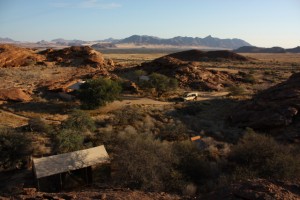
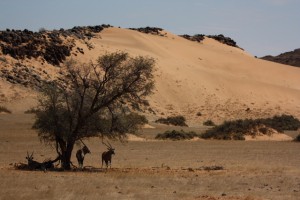
“Charles, how often do you see desert adapted black rhino in these conservancies?”
This was the question I eagerly asked our guide and he responded that one or two sightings are recorded every 6 months. Now, being a guide myself I knew that the chances of even seeing a track were remote. Nevertheless my enthusiasm was not curbed and after a lunch at the Save the Rhino trust base, we headed off on our way to Damaraland Adventure camp. After a few hours of heavy 4×4-ing, Charles asked if I could see the tracks on the road next to the vehicle. I looked eagerly, and realised here were extremely fresh black rhino tracks, heading the same direction as we were going. Pulse racing and excitement revving high, we inspected the tracks in more detail! Extremely focused on the task at hand, one of the other guests quietly said “There it is.” We all looked up, and there, not 100 meters from the vehicle, was a fully grown desert adapted black rhino bull. These creatures are not known for their friendliness, and especially the desert adapted kind, as they usually head off at a rate of knots at the first sign of humans. Blown away just by the chance to see this great beast, we were astounded when it casually began feeding and moved towards us. Trying not to disturb him, we repositioned and watched him go about his business, completely relaxed with our presence. It really was a great privilege to spend time with one of only about 180 of the amazing creatures that are left.
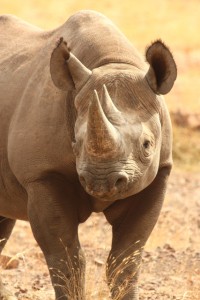
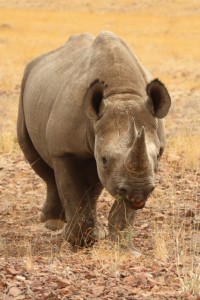
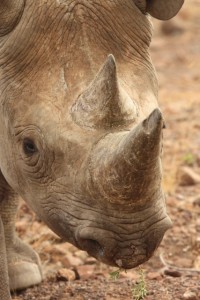
Riding the wave of euphoria from the rhino sighting, we continued on our journey to our camp. Not 3km down the road, still dazed from what we had just seen, I looked to my left and saw something running along the road next to the car. ‘STOP. LION!’ The car screeched to a halt and there it was, a two month old lion cub! Turning around, it was evident that it was not alone and a lioness with a further 3 cubs trotted across the road. Not being accustomed to vehicles, she let us know how she felt with a few soft growls so we gave her space and watched from a distance. Now I have seen many lions and had lots of encounters with lions over the years, but this has to be one of my best experiences. The fact that these lions are rarely seen, that they are extremely adapted and strong, combined with the sheer surprise of actually seeing them will remain with me forever. We were blessed again a few days later when we came across them again in a dry riverbed, about 30km from where we saw them last. This just shows the distance they have to travel, as 30km for a lioness with 4 young cubs is a big ask, but one I am sure they do on a regular basis as that what it takes to survive these harsh conditions Damaraland is known for.
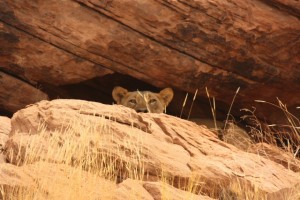
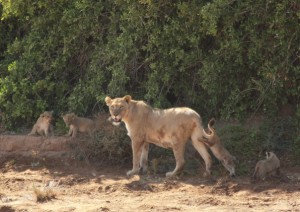
The three days that we spent in Damaraland was also special in terms of Desert adapted elephants. These unique creatures have adapted to survive long periods without water, and get as much nutrients from dry vegetation as they can. Normal elephants will drink once a day, but these pachyderms can survive by just drinking every 3 to 4 days. The area we were in had three herds that can be seen. They frequent the Haub River valley, and spend the majority of their time feeding on Ana tress and various other riverine vegetation. We were very fortunate to be able to spend a few hours with one of the herds, and on the third day, another hour or so with a different herd. They really are unique creatures, and you can see certain behavioural adaptations when watching them. You can even see how they do not feed on one tree for two long, as they know if the destroy it in one sitting, it will be gone and won’t be available for the next time they pass. It was such a privilege just to be there and watch these amazing creatures that survive in such harsh and adverse conditions.
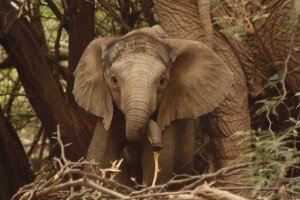
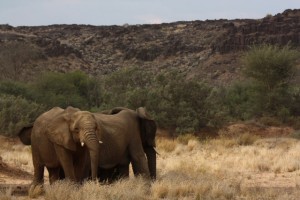
Damaraland is a timeless place that exudes complete peace and wilderness. If you get the chance, come join me on my next foray through Namibia, and we will experience this together.
Yours in conservation,
Chris
Text and photography courtesy of Chris Renshaw





